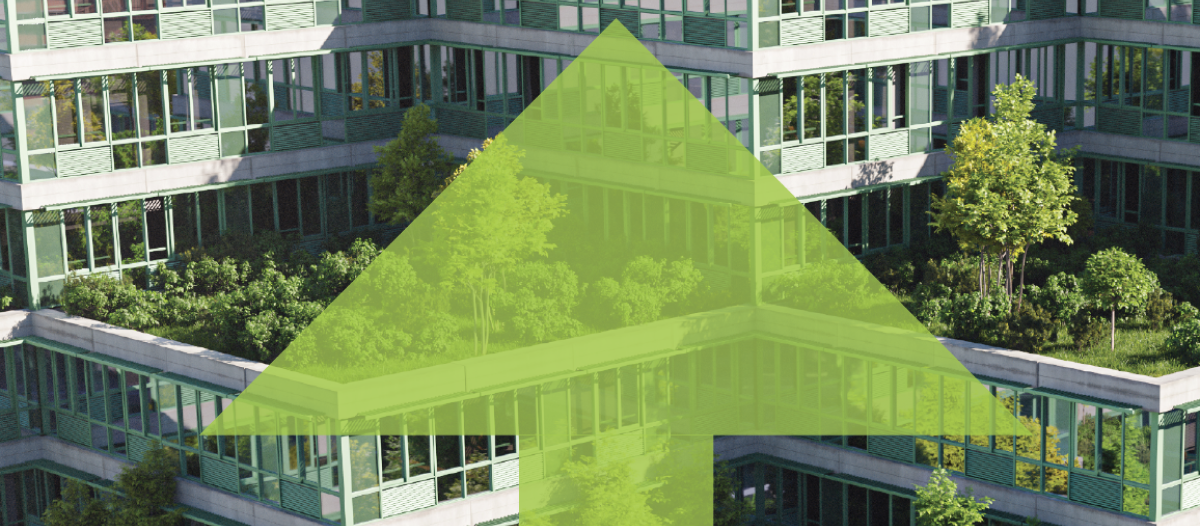The Intersection
Sustainability, excellence & the future of work

The size of the United States green building market has recently surpassed US$81 billion, with a 21 percent market share in the commercial office sector. While great strides have been made in reducing emissions through increased efficiency (11.4 percent reduction for the commercial sector from 2005-2017), the growth of commercial real estate total square footage and subsequent emissions far outpace sustainability efforts – total commercial square footage is expected to grow by 40.5 percent from 2016 to 2050 and direct emissions to grow by 20.4 percent.
This market growth, steadily strengthened by a shift in investor priorities towards green building, coincides with a unique inflection point circling the commercial office sector on the tenant side – what is the purpose of the physical workplace? And how can it be leveraged as a strategic collaboration and productivity asset to drive innovation and value for an organization?
During this age of worker choice when, for more workers than ever before, the office competes with employees’ homes and other destinations, taking a holistic approach to corporate sustainability and the workplace is required. This involves redefining what a truly smart workplace is, understanding and supporting the value of collocated, hybrid and remote work, and considering how this relates to square footage demand and function in the first place.
More aggressive localized regulations, prioritization of corporate environmental, social and governance (ESG) goals, and general heightened awareness around the urgency of action demand more widespread, mainstream access to and adoption of the practices and solutions brought to bear in the booming green building marketplace. Paired with an overall reconsideration of worker and workplace needs at the organizational level across sectors, there is a unique opportunity for building sustainability to take a stronger foothold by aligning the green market expansion with a right-sized assessment of commercial tenant demand for space. Understanding and addressing challenges for green building initiatives, defining and leveraging the benefits of doing so in a holistic manner, and taking a practical, strategy-based approach build a strong business case for commercial tenant investment.
Broadening benefits & drivers
It is well known that smart and sustainable building and operating practices benefit the environment. Buildings overall account for approximately 40 percent of worldwide emissions, and the commercial sector is responsible for a significant portion of this percentage. Developers, architects and building owners continue to address this head-on, responding to accelerating pressure from both the investor side and the tenant side to offer green buildings, which usually come at a higher price point.
And while taking occupancy in a green building comes with a higher upfront cost for tenants, more corporate real estate executives are beginning to adopt financial models recognizing that the long-term financial benefits associated with lower energy costs and tax incentives outweigh the higher capital expense. Meanwhile, employees are asserting their ability to shift to employers whose organizational priorities align to their personal priorities, and 65% of them are more likely to work for a company with well-established environmental policies. This points to a broader talent-driven consideration about sustainability, workplace experience and future-of-work priorities.
Despite this wide-ranging and growing appetite for more aggressive sustainability adoption and operational transformation, challenges remain for corporate real estate, facilities and employee experience leaders in defining a clear path.
Challenges
The decision to commit to sustainable practices in corporate real estate projects is not an easy one or one met without pushback or hesitation. Many corporations feel pressure and motivation to incorporate more sustainable decisions, but struggle to define a clear path forward and leverage a comprehensive ESG strategy to truly push the needle on reducing negative impacts from corporate real estate. The path forward is complicated by perceived risks to sustainable decisions; many assume sustainable practices add additional cost and design time to projects. Additionally, many projects focus on keeping capital expenditures low and downplaying long-term cost savings, making sustainable decisions that are more expensive upfront but save money down the road less attractive. Finally, many organizations do not take advantage of recent advancements in sustainable construction and repositioning practices. Instead, they rely on the status quo when making core building infrastructure and smart building technology decisions, whether for new construction or continued refurbishment of existing buildings.
Other challenges lie in sustainability standards. As building technology advances and more comprehensive and detailed data becomes available, ESG-minded investors and organizations are raising the bar for acceptable building energy use, emissions and water use. This has the potential to push standards beyond existing frameworks and may require organizations to look further than LEED alone to be considered truly sustainable and meet the expectations of investors, tenants and employees. This leaves organizations in a murky place when it comes to which sustainability metrics to use as benchmarks and which certifications to pursue.
Despite obstacles associated with an evolving and localized regulatory and standards landscape, the need for building sustainability is more pressing than ever. It also presents an opportunity to maintain industry relevance and drive innovation with the benefits conferred by taking action as opposed to doing nothing.
Impact & feasibility
Before defining an ESG-focused corporate real estate strategy, companies must understand what their people and organizations truly need and want. Designing and pursuing a good strategy sits at the crossroads of feasibility and impact. Just as airlines cannot abandon their core business of flying planes because of emissions-heavy jet fuel without having a viable alternative, facility managers cannot shut down their facilities and walk away. Corporate real estate decision makers must consider what is feasible for their situation in addition to understanding which changes lead to the greatest impact.
To begin, consider the current state of an organization's real estate portfolio – how many offices are there? What is the return-to-work plan? Is the organization breaking ground for a new headquarters or considering refurbishment of current space? These considerations are essential for defining the baseline vision and goals for the strategy. Keeping these and the triple bottom line of profitability, environmental impact and social good at the forefront helps allay fears and define goals all stakeholders can support.
Understanding space needs
Understanding space needs is the first order of business for organizations pursuing sustainable corporate real estate strategies. There are a variety of smart building technology solutions that inform and supplement corporate real estate decision making. Space utilization technologies, such as occupancy sensors, allow real estate and facilities personnel and space managers to optimize overall portfolio square footage needs and understand the granular utilization of their spaces to inform smart allocation and programming decisions respectively. Emerging digital twin technologies allow for a 1:1 virtual replica of a physical building and all associated technology, equipment, people, environmental components and sensors. This confers comprehensive, accurate and granular data.
Data sources combined with advanced, integrated analytics allow for actionable analysis of utilization, energy/emissions metrics, and wellness indicators. Relevant data points pulled into analytics include badging data, occupancy sensor utilization data, IoT sensors environmental/wellness indicators, wireless data, end-user systems data and more. Additionally, many emerging analytics platforms provide intelligent, AI-driven recommendations for increased space optimization.
These data points and analytics platforms detailing and analyzing how employees use space can be leveraged to emphasize what employees want out of their workplace and what creates value for the organization in floorplans, while cutting back on or repurposing underutilized space.
Automation & efficiency
Beyond guiding corporate real estate decision making, smart building technology can provide real-time automation of lighting, heating and cooling to increase energy efficiency and reduce emissions. Smart lighting solutions detect occupancy and automatically turn lights on or off depending on whether a space is occupied. Smart shade solutions similarly provide shade or sunlight depending on the time of day for any building, maximizing natural light and warmth while minimizing overheating and over lighting. Automated HVAC systems working in tandem with sensors can automate the cooling and heating of spaces based on occupancy and individual tenant needs.
In an operational context, automated IoT solutions have historically required management at the individual solution level. Advancements in intelligent orchestration via digital twin solutions are enabling the AI-enabled management of IoT technology and other connected systems. This allows logic-based automated action to be taken from data and takes some of the day-to-day solution management burden off support teams.
Of course, decisions for core infrastructure, including HVAC systems, windows, insulation and the like must also be considered as part of an overall sustainability strategy. Organizations should work with trusted construction and architecture partners to find cost-effective, low impact building design and refurbishment solutions in this area that are tailored to their specific geography.
Taking a practical approach
A sustainable strategy for corporate real estate starts with an internal view of space needs and consideration of the purpose of the workplace. The easiest way to reduce the impact of your real estate is to have less of it. Where remote work is feasible, organizations can consider investing more money into less space to provide a high-quality collaboration and culture-building asset that provides benefits not found within the home office and maintains high efficiency in its utilization. If remote work is less feasible, it is still important to consider ways to increase efficiency and improve utilization metrics. Corporate real estate was not utilized to its full potential even before the pandemic, and trends in space optimization have accelerated in recent years. Defining an organization-specific vision for what the purpose of the physical workplace is, how it drives value for the business and how it meets the needs of employees needs to be the starting point in determining green building investment and space optimization efforts in tandem.

Julia Kean is principal and head of workplace innovation at Xyster Consulting, a management consulting firm that advises and delivers on workplace strategy and technology enablement initiatives. Over the last eight years, Kean has held various positions at the firm driving organizational changes for companies of all sizes. Her latest work focuses on taking a human-centric approach to reimagining the concept of the workplace while leveraging data and technology to provide more equitable experiences and meaningful connections across physical and digital environments.
Read more on Sustainability and Real Estate or related topics Real Estate Management , Sustainable Facility and Operational Technology
Explore All FMJ Topics









